The black walnut can defy climate change in Germany. It impresses with its shady crown, its heat tolerance and its special nuts.

You could use the black walnut (Juglans nigra) than the somewhat more sophisticated sister of the walnut (Juglans regia) describe. Because their demands - for example on soil or water supply - are somewhat higher. Thanks to its good heat tolerance, it can be one of the future-proof climate trees be counted. If the black walnut feels at home in its location, it grows quickly and is therefore an excellent choice as an impressive shade provider for large gardens. This article explains everything you need to know about cultivation: from planting the black walnut to care and harvesting.
contents
- Black walnut: leaves, fruit and origin
- Plant black walnut: location, time and procedure
- The right care
- Propagating black walnut
- Harvest, effect and use: is the black walnut edible?
Black walnut: leaves, fruit and origin
The black walnut belongs to the walnut family (Juglandaceae). It originally comes from North America, but came to the United States as early as the 17th century. Century across the Atlantic to us. In recent years, their importance in Germany has once again increased significantly. It needs a warmer climate, is wind-resistant and not very susceptible to diseases and pests. That's the way to go Juglans nigra also in forestry as a substitute for less heat-tolerant tree species. A nice side effect: its noble, reddish-grained wood is decorative and very popular.
The leaves of the black walnut are pinnate like those of the walnut, but instead of five to nine, the black walnut has up to 23 pinnate leaves. These sit in pairs or unpaired on 30 - 60 cm long petioles.
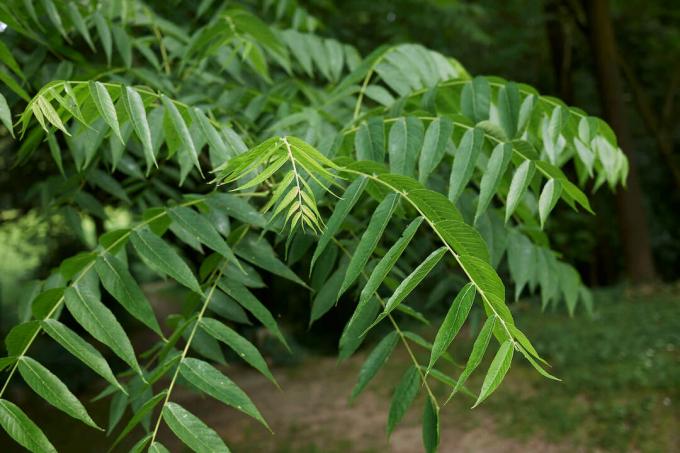
Black walnuts are monoecious, so there are male and female flowers on one tree. However, self-pollination is prevented in most black walnut varieties by their dichogamy. This means that male and female flowers of a tree bloom at different times and therefore cannot pollinate each other. It is therefore necessary for a rich harvest that there is another black walnut variety with a different flowering time in the vicinity.

At first glance, the infructescence of the black walnut resembles that of the well-known walnuts. On the tree, the nuts are still covered by a yellow-green outer shell that can be up to 6 cm thick. Only after the fruit has fallen from the tree in autumn does it begin to turn black and rot. This reveals the actual nut, which is thick-skinned, dark brown, grooved and ribbed.
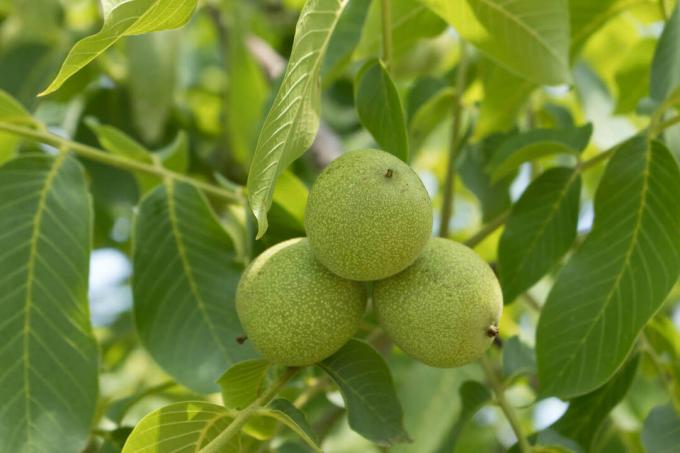
Plant black walnut: location, time and procedure
The demands of the black walnut on its location are relatively high. The soil should be rich in nutrients, deep, loose, slightly acidic to calcareous and well supplied with water. In addition, it is growing Juglans nigra preferably in sunny, warm and wind-protected places, as they are often found in wine-growing regions. Since black walnut trees usually grow to over 30 m in height and develop large, spreading crowns, they need a lot of space - both above ground and underground for the extensive and deep root system.
Once you have found a suitable location, you can start planting the black walnut:
- Best planting time: April to November; Caution: Young trees are still sensitive to frost.
- Dig a comparatively large planting hole: at least 50 x 50 x 50 cm.
- Soil if necessary with nutrient-rich potting soil such as ours Plantura organic compost improve. The high proportion of organic matter has a positive effect on the water retention capacity, among other things.
- Insert tree, set tree posts for a connection.
- Fill the planting hole with a mixture of soil and nutrient-rich potting soil and press down firmly.
- Possibly drive in tree posts even deeper, tie a stable connection.
- Model a casting ring from excess soil and mulch the tree disc.
- Water generously and water regularly for the following weeks.
You can also grow a black walnut tree from seed, but it will then take at least 10 years before you can harvest the first fruits. The procedure is described in more detail in the section Propagating Black Walnut.
Tip: If you want to get a good harvest, you should also make sure that there are other varieties of black walnut in the vicinity. This allows the trees to fertilize each other.

The right care
The black walnut tree actually only needs some attention in terms of care in the first years of growth, because then it is still in the critical phase of growth. So you should water the tree regularly in the first few years during longer dry periods and fertilize annually in spring. For example, ours is ideal for this Plantura organic universal fertilizer which releases nutrients into the soil over a longer period of time, ensuring a continuous supply of your black walnut.
When the tree is older and well established, it usually no longer needs to be fertilized thanks to its large root system.
In the first few years Juglans nigra can also be cut, but this is not absolutely necessary. You can use walnuts as a guide when cutting. The time should be in the summer, otherwise the black walnut will "bleed" profusely, i.e. it will transport water and nutrients out of the interface via the water-carrying xylem. Black walnuts must not be cut at the time of sprouting. Otherwise the cut can weaken them so much that they perish.
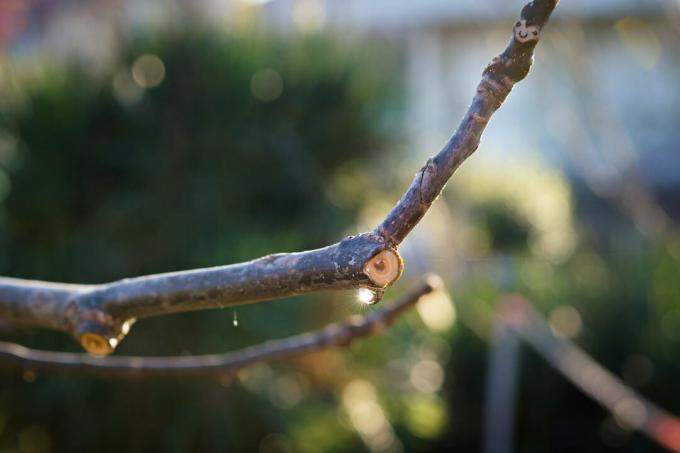
One care measure that becomes more and more labor intensive with age is removing the leaves in the fall. The leaves contain a glucoside that is converted to juglone through microbial degradation and oxidation. Juglone is a so-called allelopathic, which inhibits seed germination and the growth of seedlings in the eaves area of the black walnut and can even kill lawns.

Tip: Like walnut trees, black walnuts can be affected by the walnut fruit fly (Rhagoletis completa) are infested, even if the annoying little creatures usually only destroy the green cover. Nevertheless, you should collect and dispose of infested fruits, otherwise the larvae will pupate in the soil.
Propagating black walnut
Black walnuts can be propagated in two ways: on the one hand by cuttings, on the other hand you can also try to grow trees from the nuts. Another possibility would be refinement, which is rarely successful with black walnut and is only carried out by professional tree nurseries.
Propagation via cuttings is usually much easier and faster.
Propagating black walnut via cuttings:
- Take unlignified, healthy cuttings without fruit set between June and August.
- Young shoots on the black walnut tree that are at least 20 cm long are suitable as cuttings. The shoot tip is cut off after 15 cm. Even slightly woody shoots can still be used. It is also a good idea to select several shoots. This way you have a backup if one of the cuttings fails to grow.
- Put the shoots in planters that are filled with soil that is as nutrient-rich as possible. Ours, for example, is ideal for this Plantura organic universal soil. If necessary, you can also accommodate several cuttings in a planter.
- Press the soil firmly and water the cuttings well.
- The cuttings like it warm and sheltered, so a spot with indirect sun is ideal. They should also be watered regularly, but waterlogging should be avoided at all costs.
- The first few years, the cuttings should still be wintered cool, but absolutely frost-free, only after about two years of growth are they themselves winter-proof.
- When the first new leaves form on the shoots, you can see that the growth was successful and the cuttings have taken root. Now the cuttings can move into their own pots. The following applies: the larger the pot, the larger the root system of the young black walnut plant. And the stronger and more robust it is when planted in its final location.
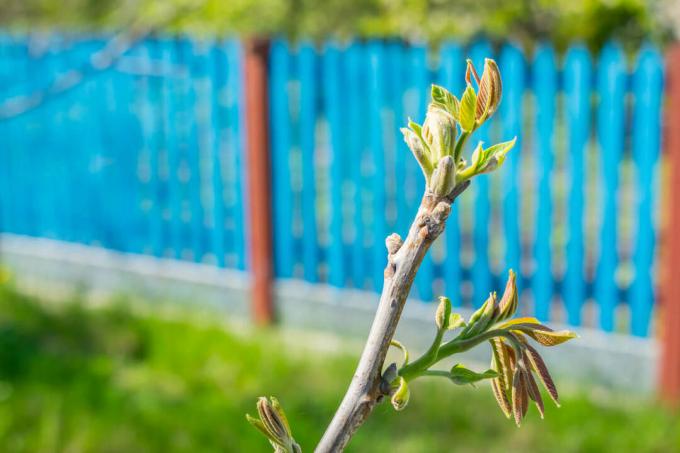
Black walnut trees can also be grown from the nuts. You should use the freshest fruit possible, because the longer they are stored, the more their germination capacity decreases. You can try to sow the nuts about 5-8 cm deep in the ground directly in the garden. However, many nuts fall victim to the mice, which is why growing them in pots offers greater chances of success. Alternatively, you can also store the nuts cold in the refrigerator for 3 - 5 months over the winter and only sow them in the spring.
- In the fall, put some fresh nuts that you have removed the fleshy husk into a pot filled with potting soil and cover them with soil. If sustainability and biological quality are important to you when choosing soil, you are, for example, with our Plantura organic herb and seed soil properly advised. It is peat-free and even the packaging is Blue Angel certified.
- Ideally, place the pot in a light, sheltered spot that is cool but frost-free.
- The soil should be kept constantly moist in the near future, but without waterlogging, otherwise the seeds could become moldy.
- In the spring, the first shoots should appear, which shows the germination of the black walnut. Then the time has come to transplant the black walnuts. Now each gets its own pot, which may already be filled with a slightly more nutrient-rich substrate.
- The plants should be watered regularly and protected from late frosts.
- These black walnut young plants are best left in pots for the next two years, so that you can put them in a frost-free place for a short time in winter when temperatures are very cold can.
- After two years, the plants should then be ready to be planted in place in the garden.
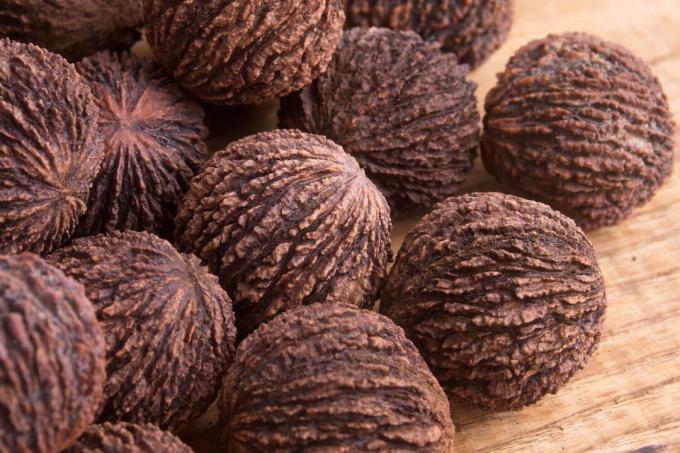
Harvest, effect and use: is the black walnut edible?
Black walnuts can be harvested in autumn. However, one should not pluck them from the tree, but wait until they fall down by themselves. Then they should first be freed from the green/black skin and then dried.

The black walnut is non-toxic and even very healthy. It's just not that easy to get hold of the edible black nuts. Cracking is hard work and usually cannot be accomplished with normal nutcrackers. But with a little creativity you will definitely find a solution, for example you can get at the nuts with a hammer. You should use cracked nuts quickly or store them as cool as possible, otherwise they will quickly go rancid. When using the black walnut, you can use other nuts as a guide. In America, where it is considered a delicacy, it forms the basis for pastries or ice cream, for example.
Some healing effects are also attributed to black nuts. For example, the nuts can have a blood pressure-lowering effect. However, real health miracles are the hard nut shells, which can be ground and then processed into tinctures. These can be used externally, for example for herpes or warts, but also help with indigestion or high blood pressure, among other things.

Have you gotten some respect for planting a black walnut tree in your yard after all? A good, slightly less demanding alternative is ordinary walnut trees. Everything you need to know about cultivation of walnuts we have summarized for you in a separate article.



